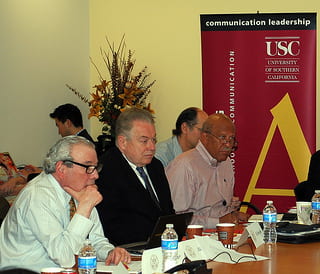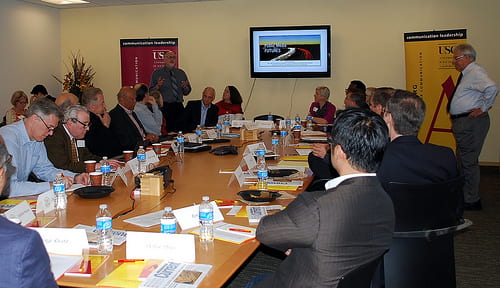Top public media executives and producers gathered in Los Angeles on April 28 to  discuss the future of public media by highlighting success stories and exploring ways in which public media could incorporate innovative programming and new approaches to sustainable funding.
discuss the future of public media by highlighting success stories and exploring ways in which public media could incorporate innovative programming and new approaches to sustainable funding.
USC Annenberg Dean Ernest J. Wilson, former chairman of the Corporation for Public Broadcasting, opened the forum off with the warning: “We either innovate or die. That’s just the bottom line.”
The subsequent dialogue centered on the themes of multiplatform news coverage, collaboration, and extending the reach of public media by targeting diverse communities in the local market. The forum, held at the headquarters of KUSC, included leaders from KUSC, KPCC/Southern California Public Radio, KCET, KOCE/PBSSoCal, KPBS TV/FM, Corporation for Public Broadcasting, and others.
Suzanne Marmion, Director of News at KPBS TV/FM, shared the success of the multiplatform news delivery model for San Diego PBS, and added that adapting radio news stories to online platforms has become a quick and successful transition. Bill Davis, President and CEO of Southern California Public Radio/KPCC, emphasized the importance of collaboration and pointed to partnerships with Spanish language stations that allow for “vertical coverage” as successful models.
 One webcast participant inquired into local public television sustainability by posing the question: “With no national franchise support (such as PBS), can local television be sustained?” According to Al Jerome, President and CEO of KCET, it can, by reinventing itself with the right program strategy. As an independent public television station since 2011, Jerome highlighted KCET’s new lineup, including the scheduling of international news programs from Al Jazeera and BBC News, along with other original programming.
One webcast participant inquired into local public television sustainability by posing the question: “With no national franchise support (such as PBS), can local television be sustained?” According to Al Jerome, President and CEO of KCET, it can, by reinventing itself with the right program strategy. As an independent public television station since 2011, Jerome highlighted KCET’s new lineup, including the scheduling of international news programs from Al Jazeera and BBC News, along with other original programming.
The dynamics of radio funding versus television was also discussed. On the topic of what public television could learn from the public radio model, Davis explained how the largest driver of donors for KPCC has been local programming, which has resulted in many small donors who are are active listeners of the station.
The need to expand public media’s reach to both local and diverse demographics was also discussed. David LeRoy, Co-Director of TRAC Media services shared a case study about Nashville Public Television. LeRoy found the success of local programming can be attributed to the audience’s desire to “hear their own voice.” This sentiment was echoed by several participants, including Davis and Ed Miskevich, Station Manager of PBS SoCal/KOCE, who stressed the importance of delivering to audience members “a voice that they feel they don’t get anywhere else” with regard to programming content.
Although the forum highlighted many recent success stories of public media, challenges remain. As Davis observed with regard to legacy media, “nobody has had a positive (financial) return on its digital investment.”
Senior fellow Adam Clayton Powell III and Mark Fuerst, director of strategic Initiatives for Current, chaired and moderated the forum.
For a copy of the powerpoint presentation by KCET’s Al Jerome, click here: KCET USC forum.pdf.
Click here to view the webcast.

This report was written by CCLP graduate fellow and USC Annenberg doctoral student Michael Park.